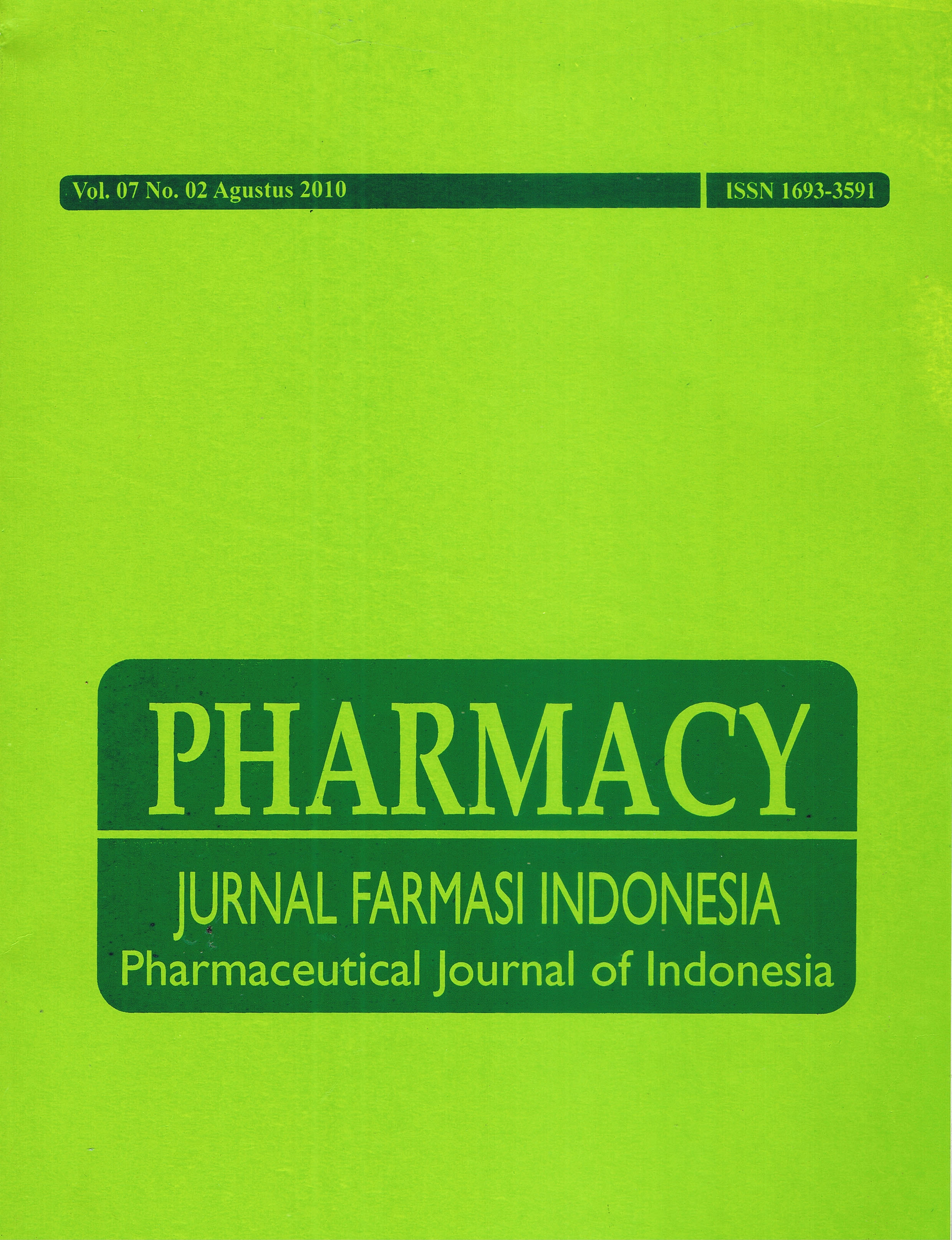PERBANDINGAN KADAR ETANOL HASIL FERMENTASI UWI VARIETAS PUTIH, UNGU, DAN ORANGE (Dioscorea alata L.)
DOI:
https://doi.org/10.30595/pji.v7i3.577Abstract
ABSTRAK Telah dilakukan Perbandingan Kadar Etanol Hasil Fermentasi Uwi Varietas Putih, Ungu dan Orange (Dioscorea alata. L). Penetapan kadar etanol digunakan alat spektrofotometer UV-Vis secara mikrodifusi dengan alat cawan Conway. Panjang gelombang maksimum yang didapat pada 446 nm, persamaan garis regresi yang diperoleh y = -0,3765x + 0,7835. Hasil validasi metode diperoleh akurasi metode dan presisi alat yang baik dengan koefisien korelasi (r) -0,9983, dengan limit deteksi 0,0546 g/dL, limit kuantitasi 0,1821 g/dL. Dari hasil penetapan kadar uwi diperoleh kadar rata-rata sebesar 3,2998%; 2,6152%; 2,6947% berturut-turut untuk sampel uwi putih, uwi orange dan uwi ungu. Kadar etanol uwi sampel berbeda bermakna sesuai hasil uji anava, dimana diperoleh nilai signifikan P lebih kecil dari α (0,000 < 0,05). Kata kunci : Uwi (Dioscorea alata L.), etanol, spektrofotometri UV-Vis, cawan Conway, fermentasi, perbandingan kadar, mikrodifusi. ABSTRACT Has been done a comparation about Ethanol from Fermentation White, Purple, and Orange Uwi Variety. Determination of ethanol using UV-VIS spectophotometry according to microdifusion and using Conway dish. Beer’s law is obeyed maximum length at 446 nm and equality of regretion line obtained by y = -0.3765x + 0.7835. The result of validation method obtained accuration of method and good precision appliance with the correlation coefficient ( r ) -0.9983. Limit of detection 0.0546 g/dL. Limit of quantitation 0.1821 g/dL. From result determination of uwi’s sampels obtained by 3.2998%; 2,6152%; 2,6947% continued for white, orange and purple uwi’s samples. Rate of uwi’s samples have different meaning of according to result of ANAVA test obtained by meaning value (P) smaller than α value (0,000<0,05). Key words : Uwi (Dioscorea alata L.), ethanol,UV-VIS Spectrophotometry, Conway dish, fermentation,comparation, microdifusion.References
Day & Underwood. 1991. Kimia Analisis Kuantitatif Anorganik. Jakarta;EGC.
Djien, Ko S. 1982. Tape Fermentation. Jakarta; LIPI.
Harmita, 2004. Petunjuk Pelaksanaan Validasi Metode dan Cara Perhitungannya. Jakarta. Departemen Farmasi FMIPA-UI.
http://dinkesbonebalango.org.18 juli 2009.
Liesbetini, H dan Ibrahim Sastramiharja. 1987. Pembuatan Etanol Immobilized Cell Saccharomyces cerevisiae Dan Bahan Baku Molase Di Reaktor Unggun Terfluidakan, naskah seminar teknologi fermentasi.Bandung;PAU Bioteknologi ITB.
Mika, I K., 1981. Mutu Brem Beras Ketan yang Dibuat dari Dua Macam Ragi dan Diperam Dalam Berbagai Wadah, Thesis sarjana THP Fetemeta IPB, hal 5-6, 9, 11, 13-14, 17. Bogor; IPB press.
Miller, J. C., and Miller, J. N., 1991. Statistika untuk Kimia Analitik (Terjemahan). Suroso. Bandung. ITB. Hal. 110-124.
Mulja, M., and Suharman. 1995. Analisis Instrumental. Surabaya. Airlangga University Press.
Sastrohamidjojo, H. 2001. Spektroskopi. Yogyakarta : Liberty.
Stewart, CP & Stolman, A. 1960. Mechanism and Analytical Methods Vol. I. New York & London; Academic Press.
Widia, S, 2001. Biokimia Eksperimen Laboratorium. Jakarta; Widya Medika.
Wilson, et al. 1971.Textbook of Organic Medicinal and Pharmaceutical Chemistry, Sixth Edition. Philadelphia, London; Lippinot Company.
Wirahadikusumah,M.1985. Biokimia,Metabolisme Energi, Karbohidrat, dan Lipid.Bandung; Penerbit ITB.
Yashinta, Y. 1989. Isolasi dan Identifikasi Alkohol Hasil Fermentasi Ketan Hitam, Ketan Putih (Oryza sativa var. glutinosa), Beras Merah, Beras Putih (Oryza sativa L.) Skripsi. Yogyakarta; UGM.
Downloads
Published
How to Cite
Issue
Section
License
Authors who publish with this journal agree to the following terms:
- Authors retain copyright and grant the journal right of first publication with the work simultaneously licensed under a Creative Commons Attribution 4.0 International License that allows others to share the work with an acknowledgement of the work's authorship and initial publication in this journal.
- Authors are able to enter into separate, additional contractual arrangements for the non-exclusive distribution of the journal's published version of the work (e.g., post it to an institutional repository or publish it in a book), with an acknowledgement of its initial publication in this journal.
- Authors are permitted and encouraged to post their work online (e.g., in institutional repositories or on their website) prior to and during the submission process, as it can lead to productive exchanges, as well as earlier and greater citation of published work (See The Effect of Open Access).






